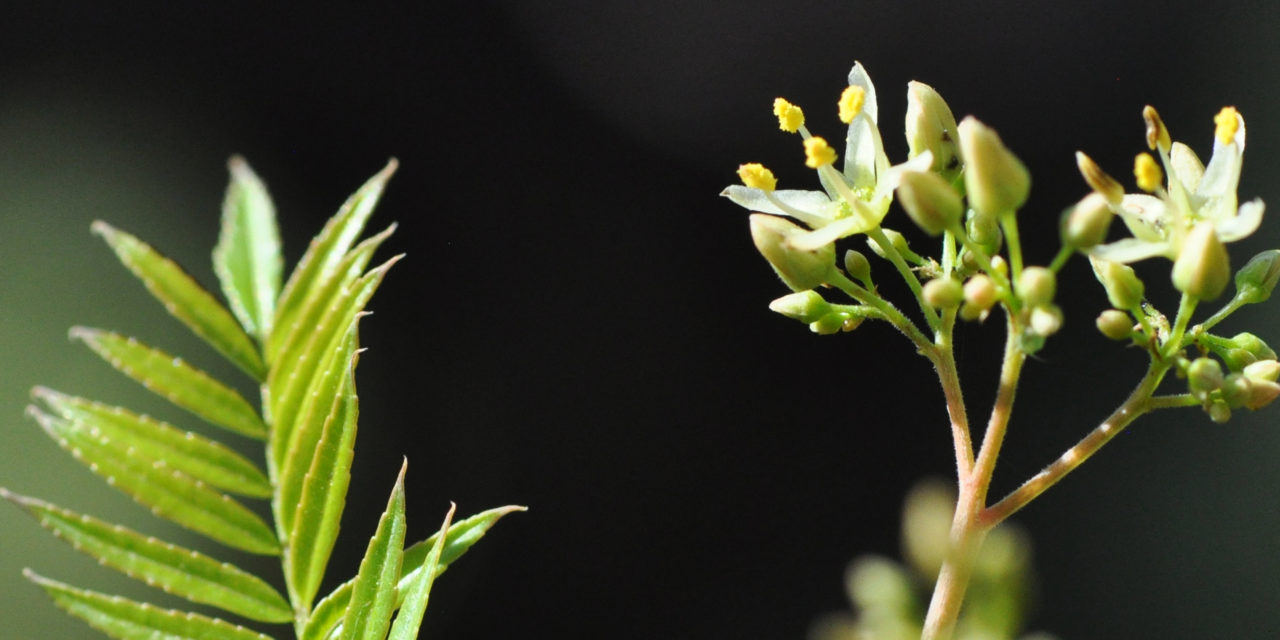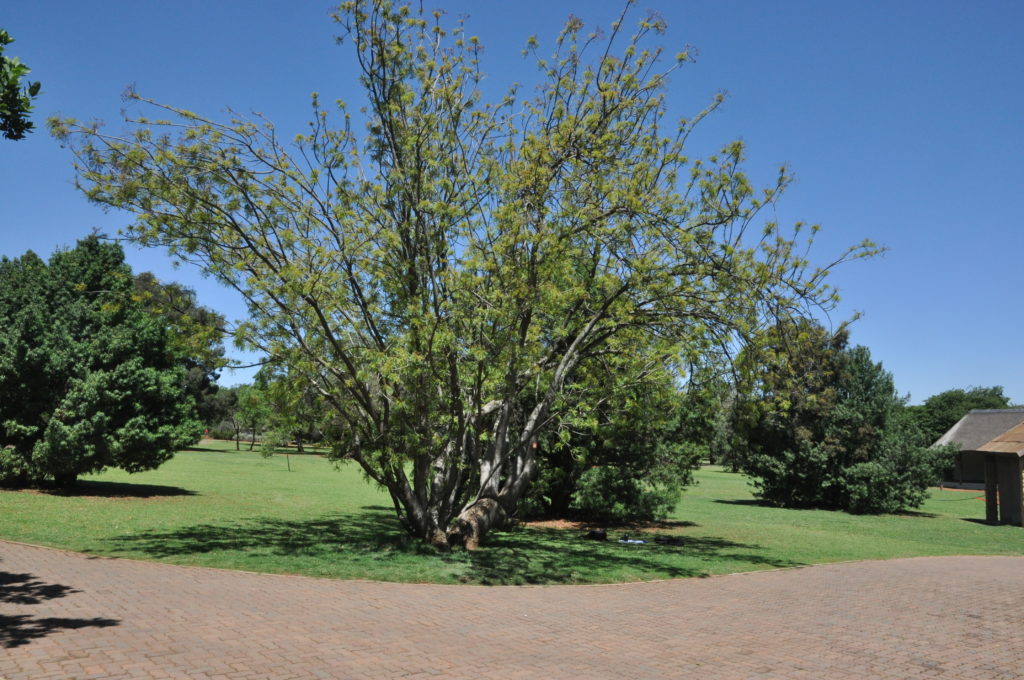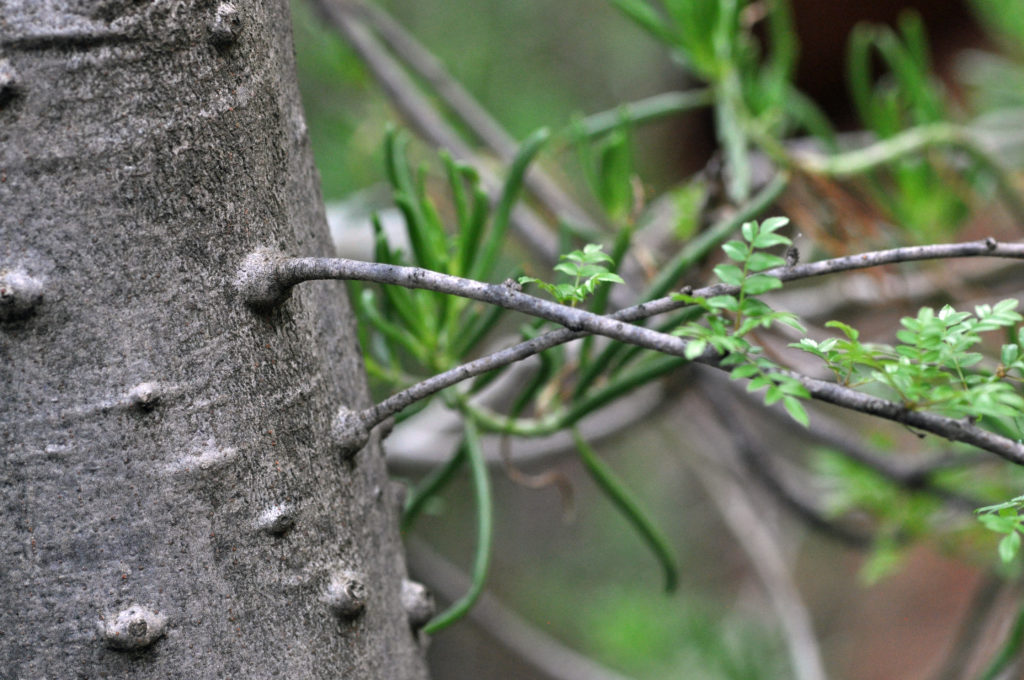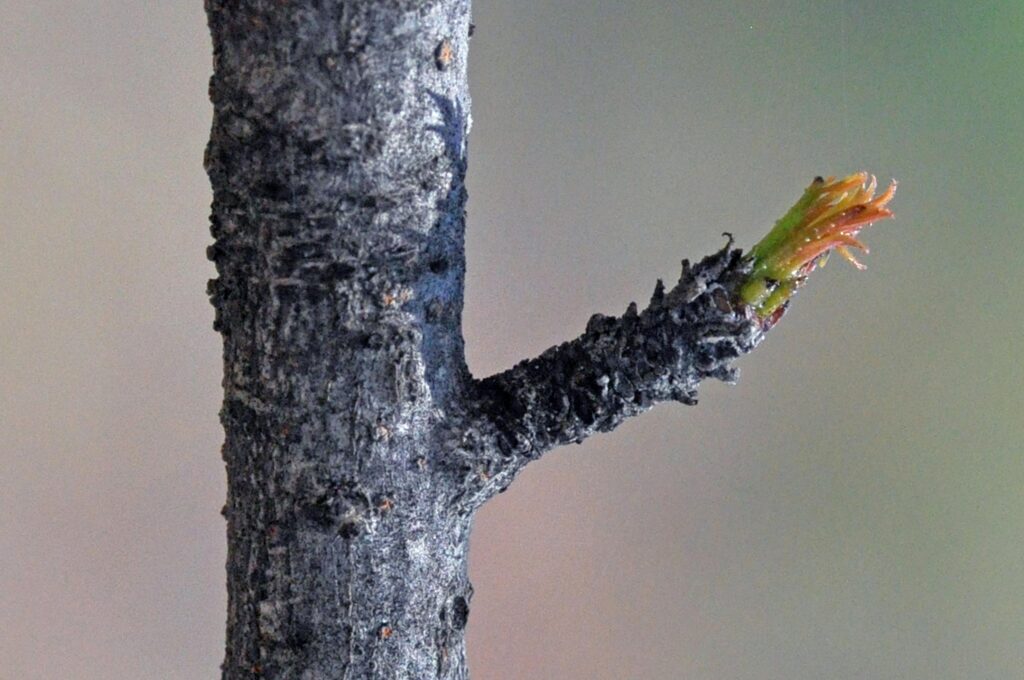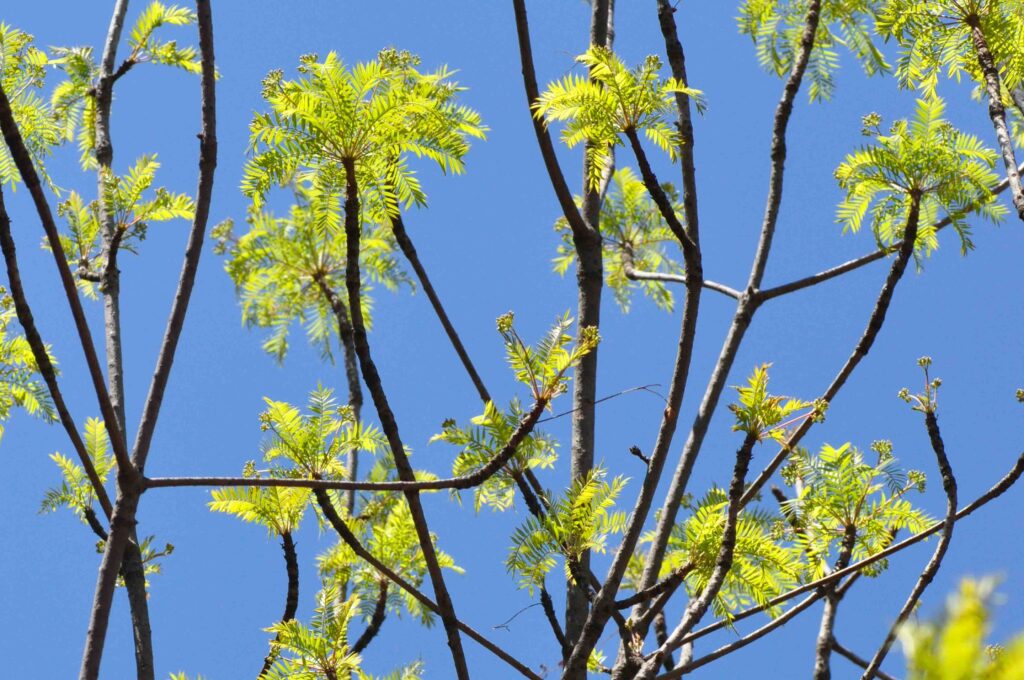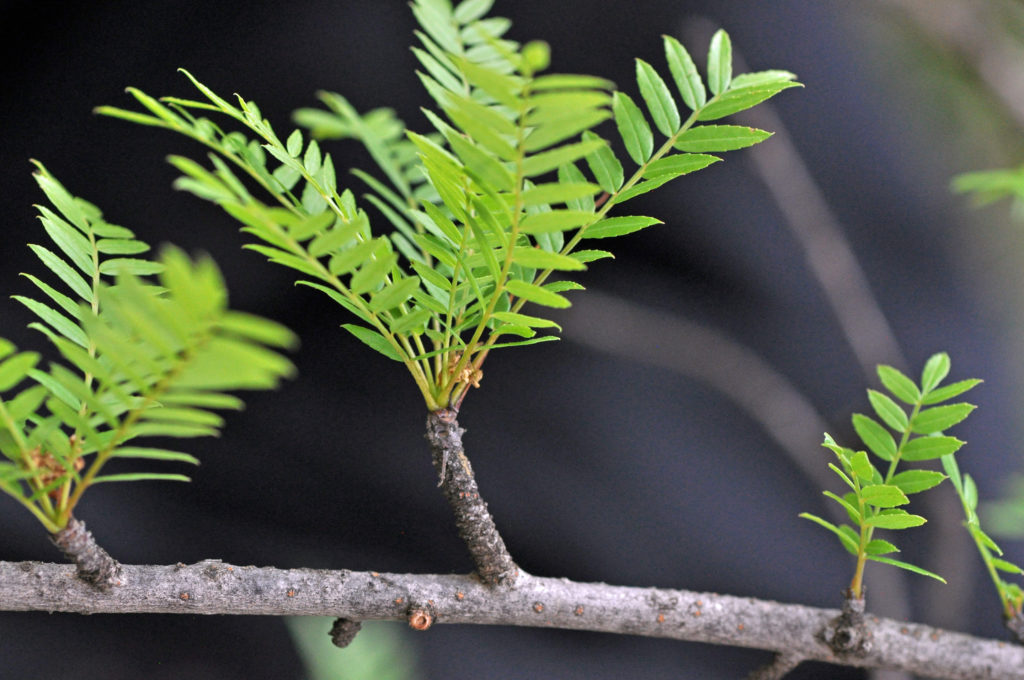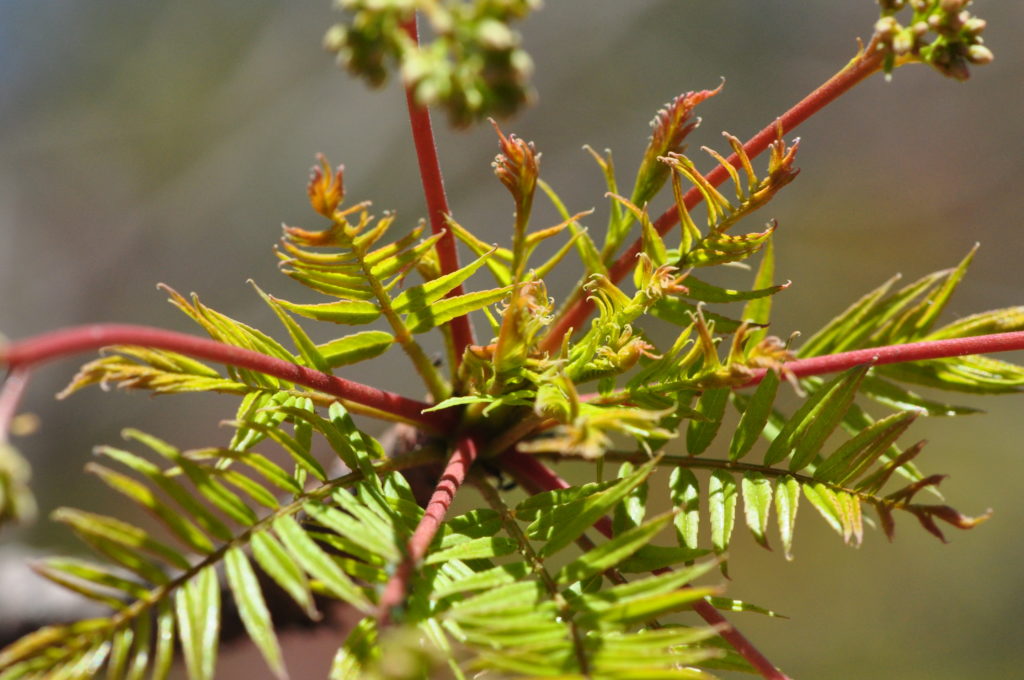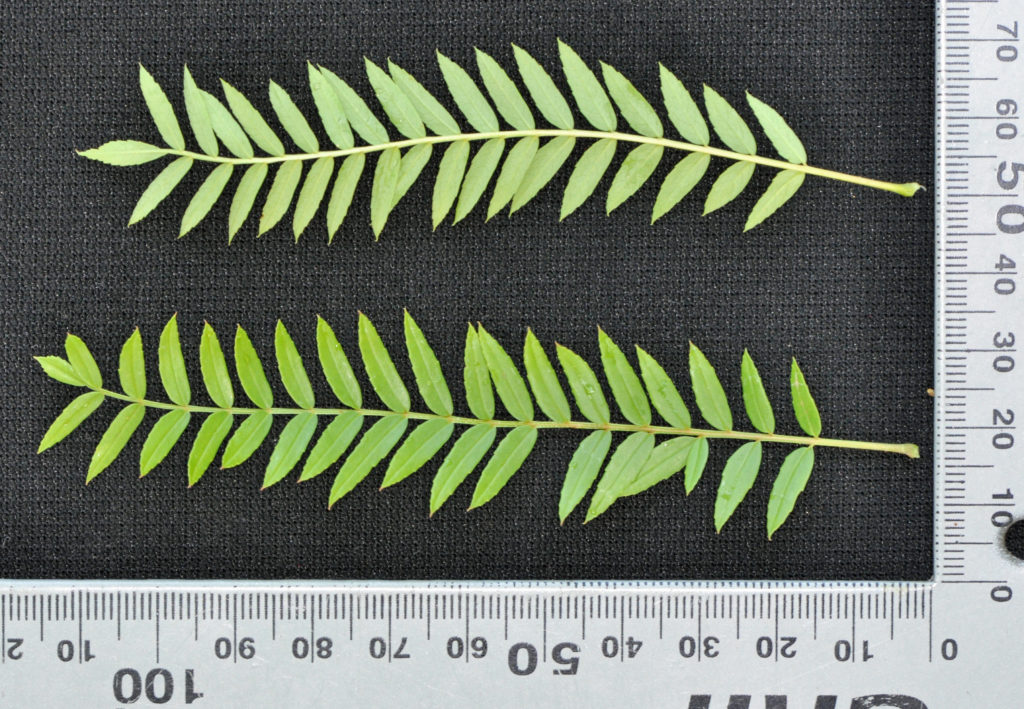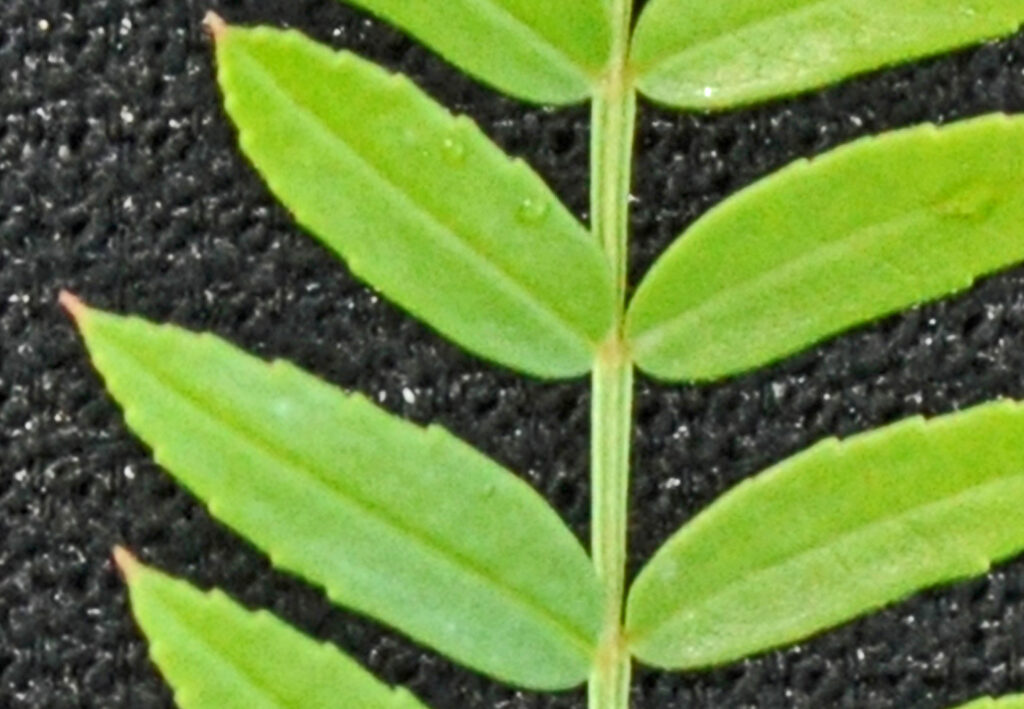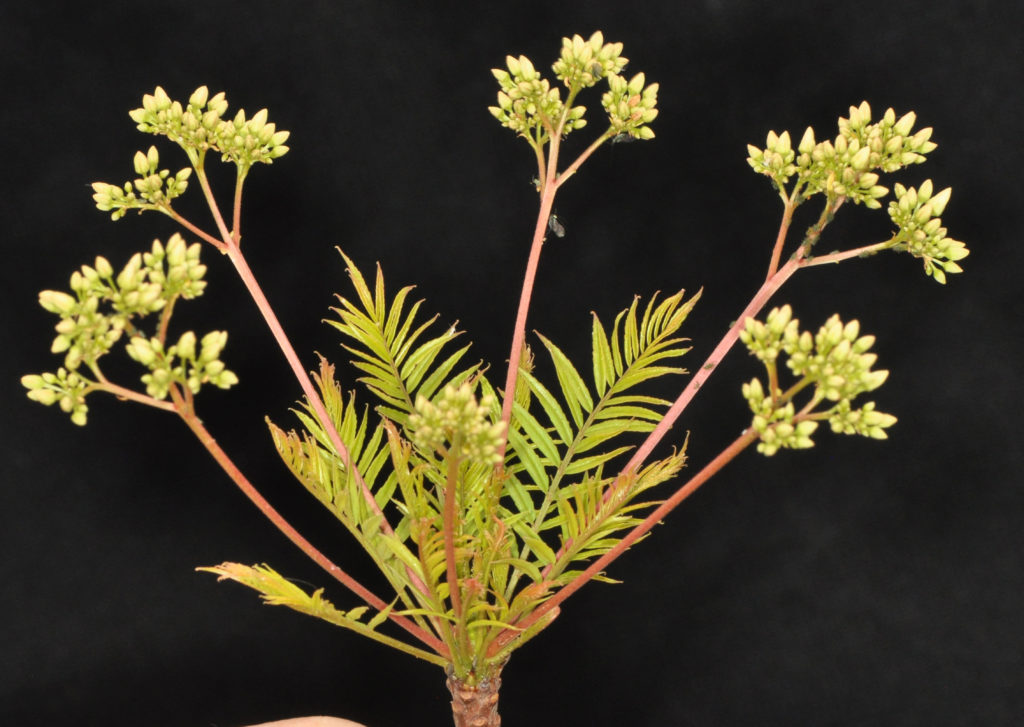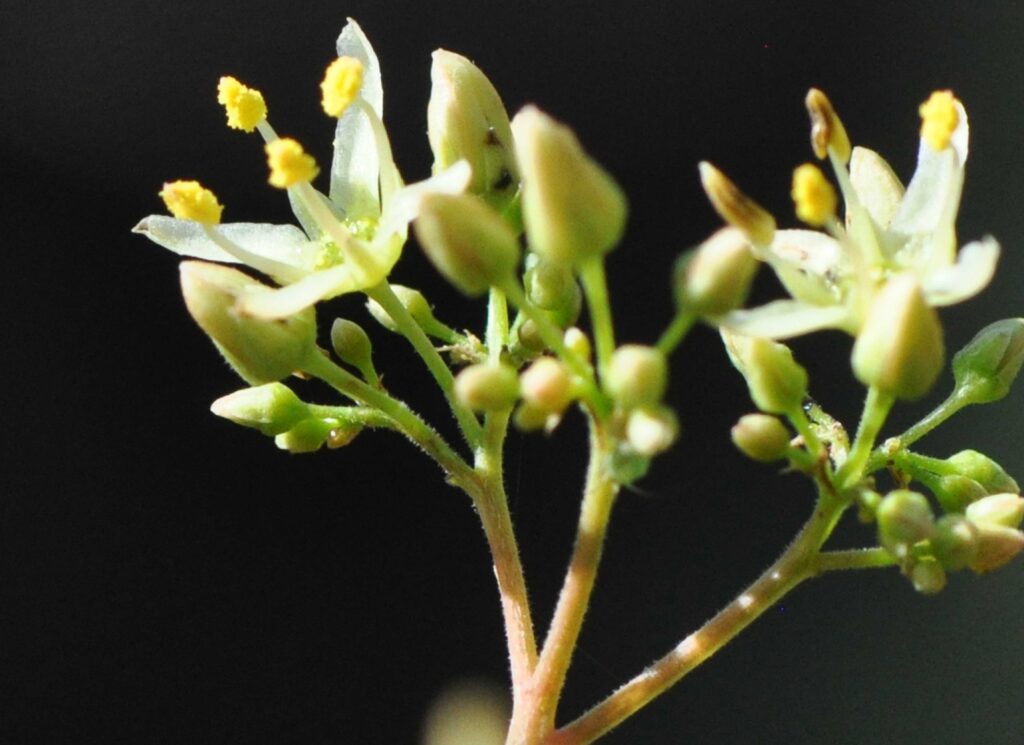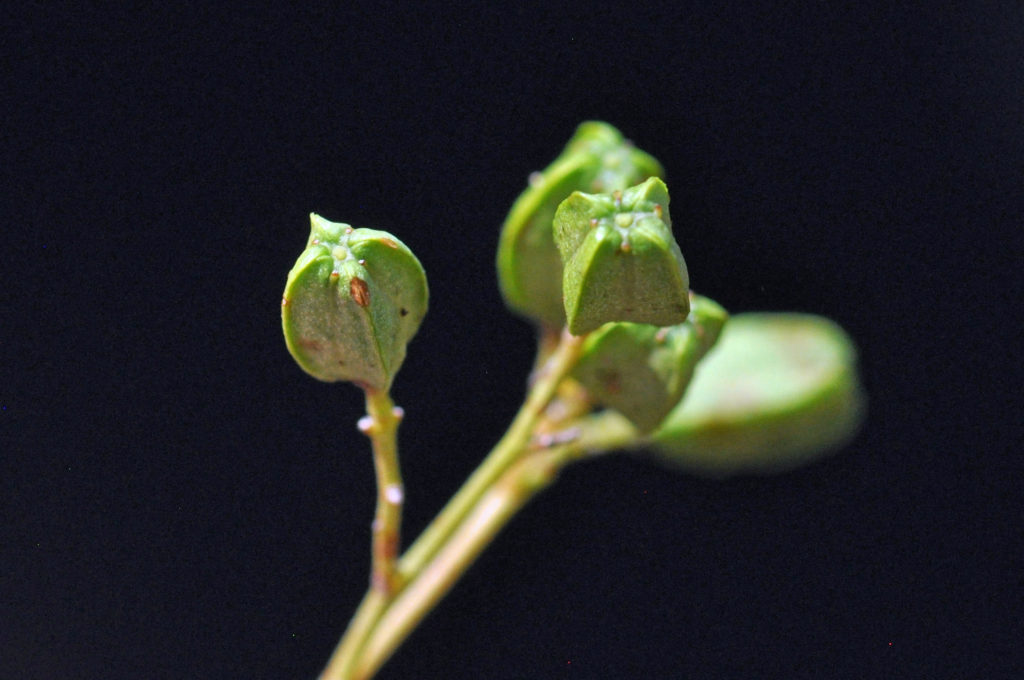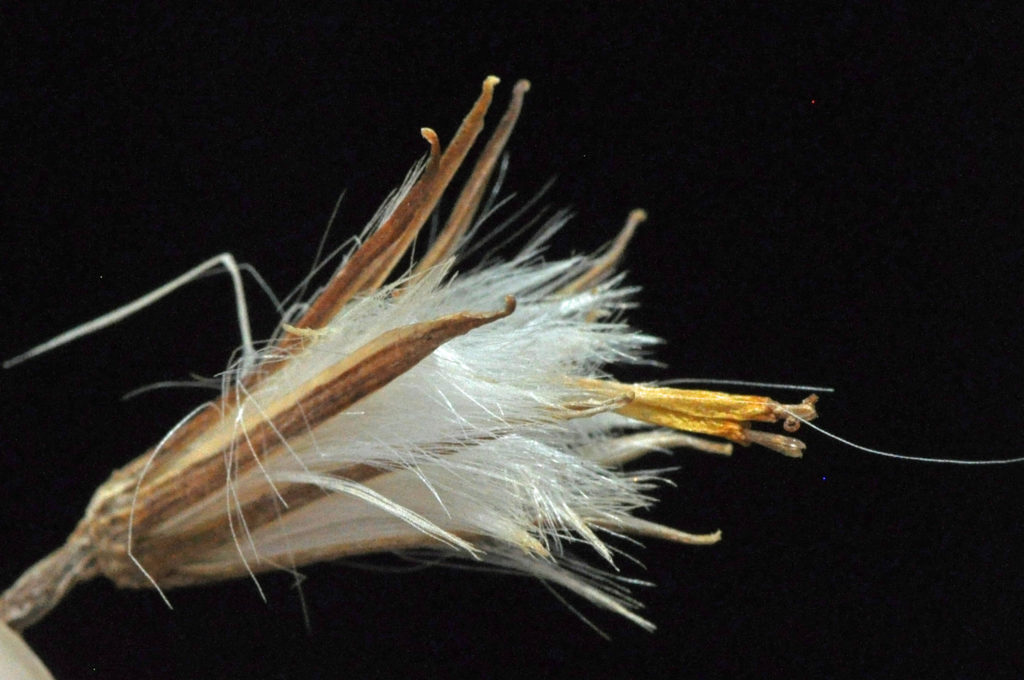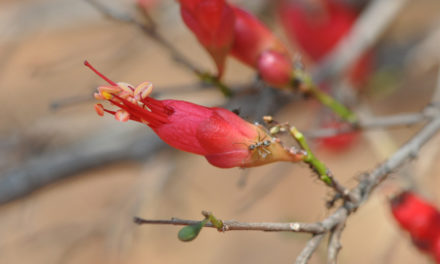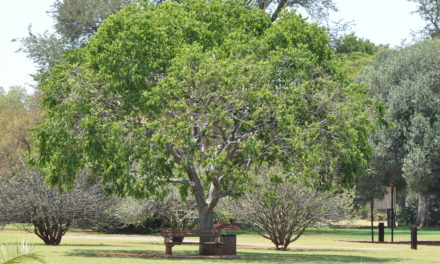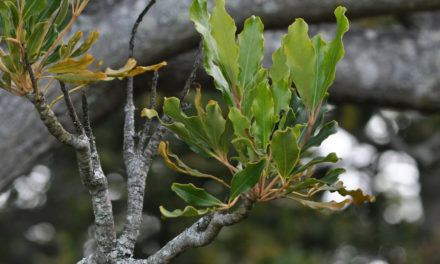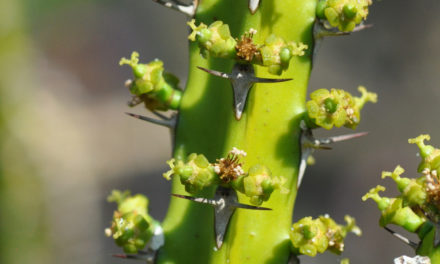General Info – summary
This monoecious Tree has underground tubers, smooth grey bark and may reach 18m high. Impressive delicate, feathery, imparipinnate Leaves lack stipules, are deciduous and produce brilliant autumn colours. The regular unisexual 4-merous Flowers occur in panicles. Male: 4 stamens. Female: superior ovary + 4 styles and staminodes are present. Fruit: a small, woody dehiscent capsule releasing triquetrous seeds.
Description
Kirkia wilmsii
SA Tree No. 269.
Common names: (Afr) Basterpeperboom, Bergsering, Slaploot, Wildepeperboom, Wilde-peperboom, Wit sering. (Eng) Bastard Pepper Tree, Mountain Kirkia, Mountain Seringa, Wild Pepper Tree. (Northern Sotho) Legaba, Modumela, Modumeta.
Family: Kirkiaceae. This family has 1 genus and 3 species in southern Africa and 1 genus in Madagascar. Leaves are often near branch ends and all lack stipules. Individual leaves are usually opposite, compound and imparipinnate with many pairs of opposite Leaflets. The trees are unarmed. Flowers occur in paniculate, bracteate cymes. Individual flowers are regular and usually unisexual. Although the tree is monoecious (having both male and female reproductive organs on the same plant), only 1 sex appears at a time. The Calyx has 4, more or less free Sepals. There are 4 free imbricate Petals and usually 4 Stamens in Male Flowers and these are reduced to staminodes in Female Flowers. Here the superior ovary (reduced in male flowers) has 4 locules, each with 1 ovule. 4 fused styles end in a capitate stigma. The woody Fruit is clearly 4-angled, dry and splits longitudinally. Seeds are triangular in cross section and have little or no endosperm (the starch and oil-containing tissue of many seeds; often referred to as the albumen).
Name derivation: Kirkia – named after the explorer who also visited the southern Africa – the Scotsman Captain (Sir) John Kirk (1832-1922). He was highly regarded as a botanist. wilmsii after the German botanist and plant collector: Dr F. Wilms (1848-1919). He was also an apothecary (person who prepared and sold medicines and drugs) who worked in Mpumalanga Province in the Mashishing (Lydenburg) area. There are 3 species of the genus Kirkia in southern Africa (2 in South Africa – the other is Kirkia acuminata).
Conservation: National Status: L C. (Least Concern). 2005 (W. Foden and L. Potter). The use of tuberous roots in local medicine and for water may become a cause of concern.
Tree
This unarmed, usually small Tree with its smooth grey Bark, may reach 11m height and several stems may be present (photo 545). Branching often occurs near the base. The blunt-tipped Branches and delicate feathery leaves help produce a rounded Crown. Branchlets have visible leaf scars with noticeably stubby, protruding tips (photo 109). There are large (up to 30cm long), Tubers (swollen underground stems that are storage and regenerative organs. These help survival during winter months). In rocky areas, Roots may produce leaves.
- 545. 2017/10/17. Pretoria NBG. Photo: David Becking.
- 346. 2016/11/08. Pretoria NBG. Photo: David Becking.
- 109. 2016/10/25. Pretoria NBG. Photo: David Becking.
Leaves
This deciduous tree has delicate and feathery Leaves that are crowded at the ends of branchlets (photo 807). They are imparipinnate (pinnately compound leaf ending in a single leaflet – photo 495). They develop impressive red or scarlet autumn colours. Young Leaflets, and each rachis (main axis bearing flowers or leaflets) are red (photos 806). Each leaf is up to 15cm long and has 10-23 pairs of usually opposite, leaflets – and the single terminal one (photos 344 & 495). Each spaced apart and hairless leaflet is translucent, narrowly ovate and up to 3 x 0,6cm. Leaflets are pale green above and slightly lighter below – photo 495). The Apex tapers to a point. The Base is often asymmetric (not equal to the opposite side (photo 495R) and usually tapers or is rounded. The usually toothed Margin (photo 495R) may be entire (with a continuous margin, not in any way indented). The Petiole (leaf stalk) is up to 4cm long and the Petiolules (leaflet stalks) are very short or absent (photo 495R). Stipules (basal appendage of the petiole) are absent.
- 807 2016.10.11 Pretoria NBG. Photo: David Becking.
- 344 2016.11.08 Pretoria NBG. Photo: David Becking.
- 806 2016.10.11 Pretoria NBG. Photo: David Becking.
- 495 2016.11.15 Pretoria NBG. Photo: David Becking.
- 495R. Pretoria NBG. 2016.11.15 Pretoria NBG. Photo: David Becking.
Flowers
This tree is monoecious (having both male and female reproductive organs on the same plant) and the small (each up to 0,6cm wide) flowers occur at branchlet ends. Here only flowers of 1 sex open at a time and this helps to ensure cross-pollination. The greenish-white Flowers are actinomorphic (Regular, symmetrical. Flowers are vertically divisible into similar halves by more than 1 plane passing through the axis). The flowers are contained in compact, many flowered Panicles (indeterminate, branched inflorescence with stalked flowers – photo 1010). Flowers occur at the ends of long red Peduncles – flower stalks (5 visible in photo 1010) that arise in leaf axils. In individual flowers, the Disc (a more or less fleshy or elevated development of the receptacle) is fleshy. The Calyx has 4 free Sepals. In the Corolla, there are 4 free white Petals (photo 110). The Male Flowers have the 4 Stamens (photo 110) arising outside the disc and alternating with the petals (photo 110). Here the Pistil (a unit of the Gynoecium, the female element of the flower, composed of the Ovary, Style and Stigma) has a reduced ovary and lacks a style. In the Female Flowers, Staminodes (sterile stamens) are present. Here the superior Ovary is 4-locular (locule: cavity within an organ e.g., ovary, anther or fruit), and here each locule has 1 ovule (egg). The 4 fused Styles (style – more or less elongated part of the pistil situated between the ovary and the stigma) have a capitate (like a head) Stigma (the part of the pistil that receives the pollen). (Oct-Dec).
- 1010 2016.10.18 Pretoria NBG Photo: David Becking.
- 110 2016.10.18 Pretoria NBG. Photo: David Becking.
Fruit
The small, initially fleshy Fruit is a Capsule (a dry fruit resulting from the maturing of a compound ovary – of more than one carpel – usually opening at maturity by one or more lines of dehiscence). The stem of the pistil expands raising the fruit beyond the rest of the flower. The initially green capsule is sharply 4-angled (photo 963), becomes brown and woody. The capsule dehisces (photo 1017) into 4 or 8 Valves (outer walls of the ovary). These split at the base and the central axis remain attached by a membrane at the top. Together they resemble a small half-open umbrella. The Seeds are triquetrous (triangular, especially in cross section) and lack endosperm (the starch and oil-containing tissue of many seeds; often referred to as the albumen). (Jan-Apr).
- 963 2018.03.01 Pretoria NBG. Photo: David Becking.
- 1017 2016.10.18 Pretoria NBG. Photo: David Becking.
Distribution & Ecology
These Trees grow naturally on dolomitic and granite formations, in mountains and rocky areas. The y also occur in Sandstone in northern Limpopo Waterberg that is alkaline with a high pH value. Shoots may develop from exposed roots and, when they do, the leaves are not initially concentrated at the branch ends. The tree is Endemic (Endemism is the ecological state of a species being unique to a defined geographic location) in Southern Africa. Plants occur in Gauteng, Mpumalanga e.g., Abel Erasmus Pass, and through the Drakensberg, Limpopo e.g., Bela-Bela (Warmbaths). The trees also appear in the North West and Eswatini (Swaziland).
Ethnobotany
A good, strong fibre is obtainable from the Bark of young stems and roots. The low-density Wood is light, greyish, coarse grained and not much used. Leaves are used to feed goats in Sekhukhuneland (South Eastern Limpopo and Mpumalanga). These plants can be Grown from seeds (spring) and from truncheons (summer). They do best in a warmish, garden with well-drained soil. In times of need, the up to 30cm long and swollen Tuberous Roots are consumed and serve both as a food and a water supply. This plant, with its red and golden autumn leaf colours, makes a good garden prospect that tolerates mild frost. A sheltered position will promote growth. Plant parts play a role in traditional medicine. Tuber extracts show anti-microbial activity (AMA).
References
Coates Palgrave, M. 2002. Keith Coates Palgrave Trees of Southern Africa, edn 3. Struik, Cape Town.
Foden, W. & Potter, L. 2005. Kirkia wilmsii Engl. National Assessment: Red List of South African Plants version 2020.1. Accessed on 2023/08/09.
Lawrence, G. H. M, 1951. Taxonomy of Vascular Plants. The Macmillan Company, New York. Tenth Printing 1965.
Palmer, E. & Pitman, N. 1972. Trees of southern Africa. Balkema, Amsterdam, Cape Town.
Schmidt, S. Lotter, M. & McCleland, W. 2002. Trees and Shrubs of Mpumalanga and the Kruger National Park. Jacana, Johannesburg.
van Wyk, B. & van Wyk, P. 1997 Field guide to Trees of Southern Africa. Struik, Cape Town.
https://en.wikipedia.org/wiki/John_Kirk_(explorer)
http://plantzafrica.com/plantklm/kirkwill.htm
http://www.operationwildflower.org.za/index.php/albums/trees/kirkia-wilmsii-il-1-5314
http://posa.sanbi.org/flora/browse.php?src=SP
Kirkia wilmsii: A Bapedi treatment for hypertension – ScienceDirect
Kirkia wilmsii Engl. | Plants of the World Online | Kew Science

